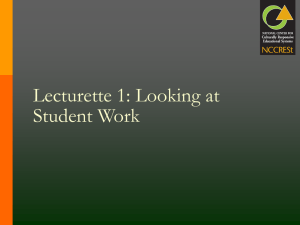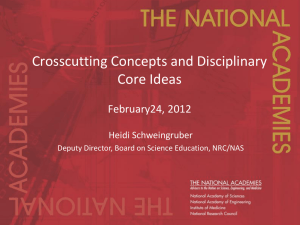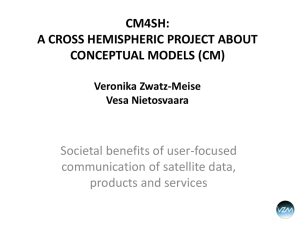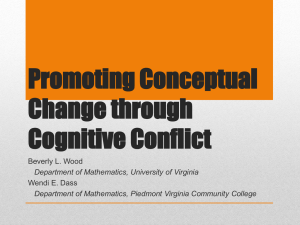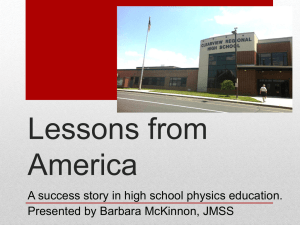A.M. Rusanen
advertisement
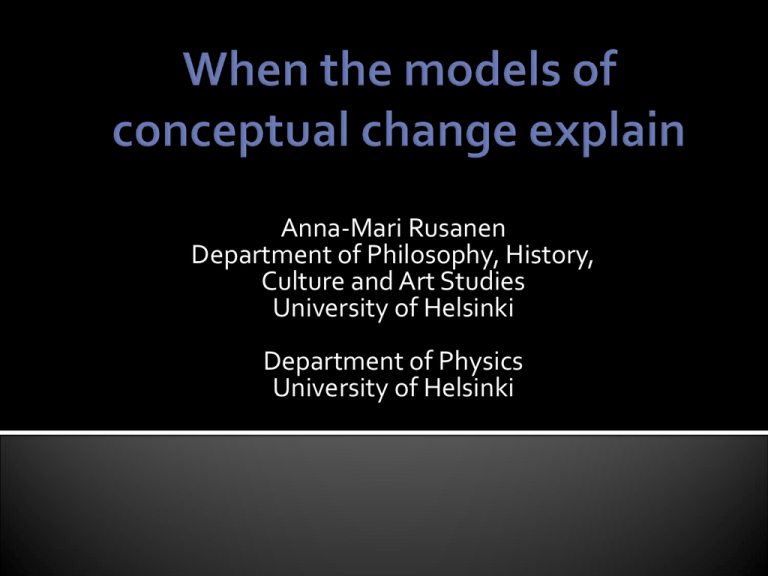
Anna-Mari Rusanen Department of Philosophy, History, Culture and Art Studies University of Helsinki Department of Physics University of Helsinki There are hundreds (thousands?) studies, which indicates the process of conceptual change is one of the key charasteristics of science learning Even within the devoted literature on conceptual change, there is no agreement on how to explain conceptual change By conceptual change cognitive scientists and cognitive psychologists mean (roughly) a specific kind of learning process: a student does not merely accumulate more knowledge, but her conceptions of phenomena in a certain domain undergo a restructuring process that affects ontological commitments, inferential relations, and standards of explanation. State 1 can be characterized: as transformation of the initial knowledge-state ( for example, a commonsense picture of the world) to one of various outcome knowledge states. The outcome: a scientific conception (when the learning process has been successful) or one of a number of unscientific misconceptions (when it has not). State 2 There are different forms of conceptual change, for example: 1)Revision: In some cases cc requires a revision of existing conceptual system For example: ▪ Category shifts (Chi) ▪ Tree jumping (Thagard) ▪ Intergration of a conceptual system (diSessa) 2) Reinterpretation: In some cases cc requires that a learner gives a new interpretation for the existing concepts/conceptual system For example: ▪ Resubsumption (Ohlsson) ▪ Differentiation and coalescence (Carey) 3) Invention: In some cases cc requires construction or production of novel conceptual systems Even in a way that makes the new and old systems ”incommensurable” (Carey) For example: bootstrapping 4) And so on… Input Outco me Typically involves: 1) analysing/characterizing the specific cognitive task (=information processing task) being performed by a system 2) describing how a certain cognitive mechanism executes/produces/sustains the phenomenon ▪ Often requires the decomposition of a complex mechanisms into simpler ones ▪ Is typically given by specifying the precise algorithms 3) describing, how the mechanism is implemented The description for the task is given by characterizing the information processing task: What is the specific cognitive task (=information processing task) being performed by a system? Why it needs to be performed? TASK? Input Outco me The characterization of information processing task creates also some constraints for the possible underlying mechanisms: Characterizes, why certain (but not all!) learning mechanism are appropriate for fulfilling the cognitive task. TASK Input Outco me Input ? not often clearly addressed in the literature, but many share the same intuition: Reorganization of the conceptual system, which (in a case of succesful learning) for example ▪ Makes the system more fruitful, intelligible etc. (Posner & Strike) ▪ makes the conceptual system more useful (Ohlsson) ▪ integrates the piecemeal structure of a conceptual system, and makes the system more coherent (Disessa, Thagard) Input ? Outco me How is the task executed/ performed? How are the inputs and outputs represented in the mechanism? How does the mechanism transform the input to generate the output (step by step )? Often requires the decomposition of complex mechanism into simpler ones Several attempts to define, but broadly (Bechtel): A mechanism is a structure performing a (information processing) function in virtue of its components parts, component operations, and their organization. A description of a mechanism should describe this organisation in a detail Many suggestions for the cognitive ”mechanisms” of conceptual change Many characterizations for the task; many suggestions for the mechanisms Two major category: Revision- mechanisms: Mechanisms underlying conceptual change revise the conceptual system by changing its conceptual organisation Production of new concepts: Mechanisms underlying conceptual change produce novel concepts/conceptual systems ”MECHANISMS” of CONCEPTUAL CHANGE PRODUCTION of new concepts by REVISION by assimilation & accomodation (Vosniadou) integration & reorganisation Concept combination (with combinatorial syntax) (diSessa) Bootstrapping Category shifting & recategorisation resubsumption (Chi) (Ohlsson) Differentiation and Coalescence (Carey) (Carey) Often the descriptions of these ”mechanisms of conceptual change” are quite shallow and offer no information about the precise structure of mechanisms/how they work For example, Chi et al: ”Conceptual change is the process of removing misconceptions… (which) are, in fact, miscategorizations of concepts” and so ”conceptual change is merely a process of reassigning or shifting a miscategorized concept from one category to another” Chi: By assimilation (=adding new information) and recategorization What is categorizing/ recategorization? “[c]ategorizing is the process of identifying or assigning a concept to category to which it belongs“ (Chi 2008, 62). Chi offers no description, how these identifyings/assignings are supposed to happen State 1 Recategorization The description ? State 2 If the structure of a mechanism is not specified, a description offers (at its best) a sketch for a possible mechanism, not a suggestion for an explanatory mechanism An explanatory model of a mechanism requires a sufficiently detailed and accurate description (Bechtel MDC, 2000; Craver, 2006/2007) When the details of these mechanisms (reorganisation, bootstrapping, resubsumption, category shifts, etc.) is analyzed: they are often just collections of some more basic cognitive mechanisms, which are ultimately responsible for the conceptual change: ▪ Categorization, mapping, transfer, assimilation, accomodation, analogical reasoning, inductive inference, abduction… Imagine, you´d have to learn a novel concept ”Cognitive architecture” How do you learn it? Carey: by building a model of the target How do you do it? A learning mechanism: By bootstrapping i.e. by using some of your existing concepts to build a new concept 1) Initial State: occurs when a learner encounters a set of interrelated explicit symbols, such as symbols of a scientific theory ”Cognitive architecture, compositionality, information semantics, representation…” These symbols, ”PLACEHOLDERS”, are uninterpreted: Are partially mapped/not mapped into any already existing concepts 2) The process of conceptual change: These placeholders are then taken up by various ”modeling processes”, which include Inductive reasoning, analogical reasoning, abduction etc. If you know something about models in physics, you might think that the structure of ”cognitive architecture” is analogical These cognitive processes ”produce” the content for placeholders 3) The Outcome: When these placeholder symbols have a stable conceptual role in a new structure, they have a conceptual content in virtue of their conceptual role The new structure may be incommensurable with the old one When ”bootstrapping” is given a description, it turns out to be a collection of some more ”basic” mechanisms: Mental modeling (?), analogical reasoning, inductive reasoning, abduction, etc. Ohlsson describes the process of resubsumption: Conceptual change happens, when a person uses analogical transfer to map conceptual system from one domain A to a new domain B, which has been earlier conceptualized by another system If the new system is evaluated to be more useful, the target domain is reinterpreted by it The mechanisms: analogy, transfer, mapping, interpretation… There is evidence that for example analogical reasoning (and transfer) play a crucial role in some forms of conceptual change BUT: not much is known, how, for example, analogical reasoning should be understood in the context of complex learning in adults (Markman) In addition, from the cognitive point of view, analogical reasoning is a complex process, and may involve several other mechanisms: Similarity comparisons, visuo-spatial mechanisms for imagination, mechanisms for mapping from one system to another… These mechanisms may involve several submechanisms ▪ there is evidence that even some motor controlmechanisms are used in some sort of mappings (number learning in childhood…?) Requires that the mechanisms responsible for a certain type of conceptual change should be specified in a detail Can be really challenging in the case of conceptual change, because it may involve a hierarchical collection of many different submechanisms Some of those are better ”known” (categorization, inductive reasoning), some of those aren´t (mapping mechanisms?) In addition, there are many different forms of conceptual change, and they may involve several different mechanisms Ohlsson, 2009: A theory of cc cannot just be the list of all possible mechanisms, it must also constraint mechanisms It must be able to tell, why certain mechanisms are appropriate for cc, and why some other aren´t For this reason, the task level also matters From a cognitive science point of view, explaining conceptual change requires: 1) A precise description for the information processing task 2) A sufficiently accurate and detailed description of the mechanisms responsible for the task can be a really challenging task! But why to bother? Do we really need to know? Yes: If you do not know, how it works, you do not know, how to manipulate it If you do not know, how to manipulate it, you don´t know, how to facilitate it
